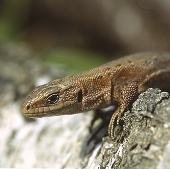

Lézard Vivipare - Lacerta Vivipara - Viviparous Lizard
(Syn English: Common Lizard)
The viviparous lizard has a rather stocky body and relatively short limbs, smallish head with rounded nose. The colour of the back is green brown, beige, grey or dark brown, a darker streak or series of spots may run the length of its body and tail, black individuals occur with some frequency. The belly is brightly coloured during the breeding period, yellow or orange with dark spots for males, less colourful for females with fewer spots or speckles, the throat is coloured shades of blue for both sexes. Length rarely exceeds 17 cm.

Viviparous lizard, France.
Found in most parts of France except the south west and the Mediterranean coastal band, they prefer a moist or wet habitat, marshland, damp leaves, wood debris, wet ditches, also frequently to be found near to a source of water where they enjoy swimming. In spite of this fondness for damp conditions, they sun themselves on tree stumps and similar surfaces, often in groups and can often be seen returning to their favourite spot. Hibernation takes place from October until March, although they often emerge for short spells during warmer periods. Sometimes large groups can be found together under logs, large rocks or in other cavities
.jpg)
Food is varied, insects, grubs, worms, and it seems that they will take bees and wasps without fear of being stung, having grabbed their prey they shake it hard and then eat it whole.
Reproduction takes place between April and June, and although males will attempt to defend a territory, the females will frequently couple with several different males during the course of a day. The young, which number between 3 and 15, are produced around three months later, and are born in an egg membrane which they normally break out of at the same moment as birth, although this can take up to three days. When born they are able to fend for themselves immediately without any assistance from their mother.
Although generally not considered to be threatened across its normal range, it has full protection in France



